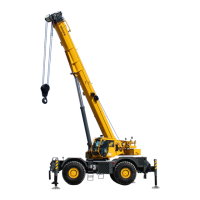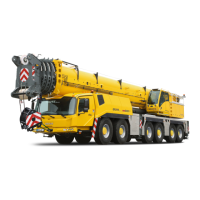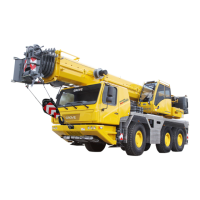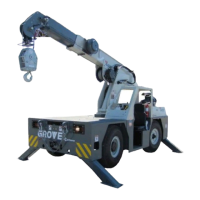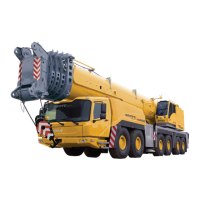SWING SYSTEM TMS700E SERVICE MANUAL
6-20 Published 01-29-2015, Control # 512-01
4. Disengage the swing lock pin and swing the
superstructure approximately 10 degrees to the right
(clockwise). Slowly swing back to the left and engage
the swing lock pin.
NOTE: If the superstructure swings past the swing lock pin
engaged position, step 4 must be repeated.
5. Loosen the three screws that secure the slew
potentiometer to the mounting plate.
6. Rotate the body of the slew potentiometer until the slew
angle indicates 0.6 ± 0.1 degree.
NOTE: The slew angle indication in step 6 may not be
obtainable due to limited wire length on the
potentiometer, or the electrical terminals
interference with one of the three mounting screws.
If this occurs, reposition the collar set screwed to
the potentiometer shaft and repeat steps 4 thru 6.
7. Tighten the three screws that secure the slew
potentiometer to the mounting plate. Install the electrical
swivel cover.
8. Disengage the swing lock pin and swing approximately
10 degrees to the left (counter clockwise). Slowly swing
back to the right and engage the swing lock pin.
NOTE: If the superstructure swings past the swing lock pin
engaged position, step 8 must be repeated.
9. If the angle indicated on the console does not exceed ±
1.0 degree, proceed to step 10. If the indicated angle
exceeds ± 1.0 degree, return to step 4.
10. Disengage the swing lock pin and swing approximately
10 degrees to the right (clockwise). Slowly swing back to
the left and engage the swing lock pin.
NOTE: If the superstructure swings past the swing lock pin
engaged position, step 10 must be repeated.
11. If the angle indicated on the console does not exceed ±
1.0 degree, proceed to step 12. If the indicated angle
exceeds ± 1.0 degree, return to step 3.
12. Disengage the swing lock pin and swing approximately
10 degrees to the left (counter clockwise). Slowly swing
back to the right and engage the swing lock pin.
NOTE: If the superstructure swings past the swing lock pin
engaged position, step 12 must be repeated.
13. Verify the angle indicated on the console does not
exceed ± 1.0 degree. If the indicated angle exceeds ±
1.0 degree, return to step 3.
SWING LOCK PIN
Description
The purpose of the swing lock pin is to lock the
superstructure in position directly over the front or over the
rear. The pin swing lock installation consists of a large pin, a
control handle in the right side of the superstructure cab, and
control linkage that allows the crane operator to set and free
the pin.
When the superstructure is directly over the front or rear,
pushing the control handle down drops the swing lock pin
into a socket on the carrier frame, locking the superstructure
in place. Pulling the control handle up pulls the pin out of the
socket, unlocking the superstructure.
Maintenance
Verify linkage is installed to avoid damage from
superstructure rotation and is undamaged. Verify pin,
turntable bushing pin passes through, and both sockets on
the frame are undamaged. Verify all attaching hardware is
secure and undamaged.
Ensure linkage is adjusted properly. If it is, the pin bottom will
stick out about 5.8 cm (2.3 in) from the bottom of its bushing
in the turntable. (If it is too far in, it might not lock properly. If it
is too far out, it might hang up). Using the jam nuts on the
linkage parts, adjust the linkage so the pin bottom will stick
out about 5.8 cm (2.3 in) from the bottom of its bushing in the
turntable; verify the superstructure can lock properly and the
superstructure can rotate without lock pin hangup.
360° SWING LOCK CONTROL (POSITIVE
LOCK TYPE) (OPTIONAL)
Description
The purpose of the swing lock is to secure the superstructure
in position at one of the positions in its rotation. There are
roughly 120 spots about 3.0 degrees apart for the
superstructure to lock to in its 360 degree of rotation. The
360 degree swing lock control pedal is on the left side of the
superstructure cab floor, left of the swing brake pedal.
Pushing the swing lock control pedal down engages the lock
between the teeth of the swing gear. Pulling up on the
release lever allows the swing lock control pedal up
disengaging the lock.
Maintenance
Verify cable is routed to avoid damage from superstructure
rotation and is undamaged. Verify swing lock assembly is
undamaged and working properly. Verify spring is
undamaged and has enough strength to pull blade of swing
lock assembly completely out of the gear teeth when the
control pedal is allowed up. Verify the linkage can put the
blade of the swing lock assembly as far as possible between
CAUTION
Do not attempt to rotate the slotted shaft in the center of
the slew potentiometer.
Reference Only
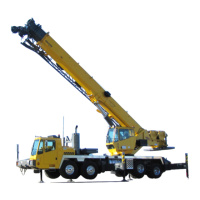
